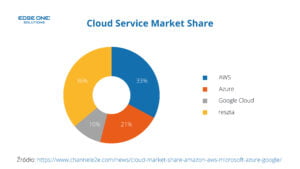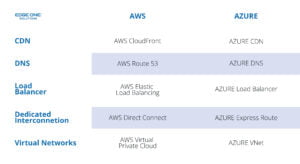Over the half-century, traditional storage devices, such as hard drives and flash memory, have driven digitization by physically connecting us to the digital world. However, in the first decade of the 21st century, public cloud services combined with modern Internet technologies caused a revolutionary change. The possibility to store data in the cloud was introduced.

To put it simply, cloud computing means physical servers in data centers. A server is a program or machine that can not only store and process data but also run programs or perform advanced analysis. Servers can be connected through a private or public network, such as the Internet.
Cloud is also a collection of hundreds of services. Public cloud services are very convenient because of the ease of accessing and deploying data without the need for hardware expansion, which is a unique benefit that traditional computing systems cannot match in the form of local server rooms.
Over time, many companies that want to satisfy users by providing these services have appeared in the world. In this text, we will look at the two biggest giants on the market, Microsoft Azure, and Amazon Web Services – currently being unbeatable.
The beginnings of cloud computing
The first on the market, fully public as an IaaS service, was a tool released by Amazon – Amazon Web Services (or AWS). It was launched in 2006 and is one of the most widely used cloud computing platforms worldwide. Companies such as Adobe, Netflix, HTC, Pinterest, and Spotify put their trust in AWS.
AWS enables customers to use a wide variety of web services. These services include everything from computing power for websites to virtual machines for hosting operating systems on the network.
Since 2008 Microsoft company has been working to create its service to compete with Amazon Web Services. Almost 80% of Fortune 500 companies use the Azure service – including Walmart Inc, CVS, and Toyota.
This service is designed to deploy, test, and manage service applications over a global network of data centers.
Market
Amazon’s tool currently is number one in the world with almost 33% of the total market share.
Azure has a 21% share of the overall market- which gives it a second place on the list.

Azure and AWS Availability Zones
The platform’s regions and availability zones are designed to provide resiliency and reliability for business-critical workloads. The platform supports multiple geolocations. These discrete boundaries define the limits of fault recovery and data storage in one or more service areas.
Platform availability zones are physically and logically separated data centers with their independent power, network, and cooling systems. Being connected to an ultra-low-latency network, they become a fundamental building block for delivering high-availability applications. Accessibility zones ensure that in case of affecting the data center’s location – such as a power or cooling failure – data is protected.
Every service region includes data centers deployed within a specific circuit timeframe. They are connected via a dedicated low-latency regional network. This design makes sure that platform services in any region provide the best possible security and performance.
The AWS cloud covers 84 availability zones in 26 geographic regions around the world, with plans announced for 24 and eight more AWS regions in Australia, Canada, India, Israel, New Zealand, Spain, Switzerland, and the United Arab Emirates (UAE).

Azure offers its services in 60 regions in over 140 countries and is planning to expand to another 12 regions.

Open-Source Integration
AWS is a great solution for Linux users and open-source developers. AWS provides some integrations for various open-source applications. The Azure platform offers opportunities for enterprise customers, so that, users can log into the Azure platform using an Active Directory service account and run the platform on Linux, macOS, and Windows.
Azure and AWS cloud computing resources
AWS EC2 (Amazon Elastic Compute Cloud) is AWS’ main flagship product. EC2 allows users to “rent” computing power to run applications. The main advantage of EC2 is its flexibility, as users can scale or change storage capacity within a couple of minutes and choose from a variety of options: processor, storage, network, operating system, deployed regions, and purchase model. AWS EC2 offers 400 different instances in 24 regions and more than 80 availability zones around the world.
Azure Virtual Machines provide scalable computing resources on-demand in a “pay as you go” pricing model. With Azure Virtual Machines, you can create and manage virtual machines with just a few clicks in the Azure portal. The latest version of the Azure portal provides new capabilities for managing virtual machines using the Azure Resource Manager deployment model.
Comparison of network functions

The largest instance offered by AWS
256 GB RAM + 16 vCPUs (virtual processors)
The largest instance offered by Azure
224 GB RAM + 16 vCPUs

Administrator, Devops, Architect
Both platforms offer many different roles, each with its unique responsibilities. One of the roles you may be interested in is Cloud System Administrator, which is responsible for deploying and maintaining virtual machines for cloud deployment, as well as creating and configuring virtual networks, providing virtual machines, database storage accounts, handling network load balancing systems, configuring firewalls and scaling infrastructure (Scale In or Scale-Out), etc.
Another role is that of developers, application cloud services engineers, who are responsible for designing and developing several types of applications that can integrate with cloud platforms, using managed services such as databases, warehouses, queues, caches, workflows, and others to kick off new applications to market quickly and at low costs.
DevOps is the role responsible for automating the deployment and configuration of applications. They are a fundamental representation of the barrier-breaking integration of development and operations to streamline the application lifecycle. The role includes infrastructure management with version-controlled source files that can be used to restore cloud environments within hours and minutes, rather than weeks and days in the traditional model.
Cloud Architect is a new position for the platform and requires a couple of years of experience in designing, installing, and administering third-party virtualization environments, as well as breakdown recovery and mitigation design.
More platform roles are coming out, i.e., Cloud Sales Executives, and Cloud Consultants, all require prior experience. Choosing the right cloud computing platform depends on the type of data organizations that are aimed to store, the location of customers, the importance of availability and reachability, and the cost of data transfer. Organizations should try to avoid relying on just one cloud computing platform.
We hope we have provided enough information about each solution, their advantages, and disadvantages, and which one might be the best for you.
Check out our current job offers.
https://edge1s.recruitify.ai/jobs
Sources:
https://aws.amazon.com/about-aws/global-infrastructure/regions_az/
https://infrastructuremap.microsoft.com
https://holori.com/cloud-market-2022/
https://holori.com/aws-vs-azure/
https://www.channele2e.com/news/cloud-market-share-amazon-aws-microsoft-azure-google/

